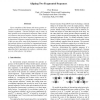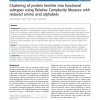222 search results - page 8 / 45 » Boosting Relational Sequence Alignments |
IPPS
2002
IEEE
14 years 9 days ago
2002
IEEE
Upon completion of the human and mouse genome sequences, world-wide sequencing capacity will turn to other complex organisms. Current strategies call for many of these genomes to ...
BMCBI
2010
13 years 7 months ago
2010
Background: Phylogenetic analysis can be used to divide a protein family into subfamilies in the absence of experimental information. Most phylogenetic analysis methods utilize mu...
BMCBI
2007
13 years 7 months ago
2007
Background: By virtue of their shared ancestry, homologous sequences are similar in their structure and function. Consequently, multiple sequence alignments are routinely used to ...
RECOMB
2003
Springer
14 years 7 months ago
2003
Springer
Protein sequence alignments are more reliable the shorter the evolutionary distance. Here, we align distantly related proteins using many closely spaced intermediate sequences as ...
ISMB
1996
13 years 8 months ago
1996
Multiple sequence alignment of distantly related viral proteins remains a challenge to all currently available alignment methods. The hidden Markovmodel approach offers a new,flex...


